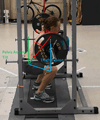Biomechanical comparisons of back and front squats with a straight bar and four squats with a transformer bar
- PMID: 33161870
- PMCID: PMC8106690
- DOI: 10.1080/14763141.2020.1832563
Biomechanical comparisons of back and front squats with a straight bar and four squats with a transformer bar
Abstract
The purpose was to quantify trunk and lower extremity biomechanics among back and front squats with a straight bar and four squats with different anterior-posterior load placements imposed by a transformer bar. Ten males and eight females performed six squat conditions: back and front squats with a straight bar, back and front squats with a transformer bar, and squats with more posteriorly or anteriorly placed loads with a transformer bar. A constant load of 70% of the participant's one-repetition maximum in the straight-bar front squat was used. Kinematic and kinetic data were collected to quantify joint biomechanics at an estimated parallel squat position in the descending and ascending phases. Squats with more anteriorly placed load significantly decreased trunk flexion and pelvis anterior tilt angles with large effect sizes but increased low-back extension moments with medium to large effect sizes. Hip, knee, and ankle extension moments were generally similar among most conditions. Participants adjusted their trunk and pelvis to mediate the effects of load placements on low-back and lower extremity moments. While lower extremity loading was similar among different squats, the different trunk and pelvis angles and low-back moments should be taken into consideration for people with low-back impairment.
Keywords: Low back; hip; knee; load placement; squatting.
Conflict of interest statement
Disclosure statement
No potential conflict of interest was reported by the authors.
Figures






References
-
- Bell AL, Brand RA, & Pedersen DR (1989). Prediction of hip joint centre location from external landmarks. Human Movement Science, 8, 3–16.
-
- Benjamini Y, & Hochberg Y. (1995). Controlling the false discovery rate: A practical and powerful approach to multiple testing. Journal of the Royal Statistical Society, Series B, 57, 289–300.
-
- Bird SP, & Caswy S. (2012). Exploring the front squat. Strength and Conditioning Journal, 34, 27–33.
-
- Bordelon NM, Jones DH, Sweeney KM, Davis DJ, Critchley ML, Rochelle LE, . . . Dai B. (In press). Optimal load magnitude and placement for peak power production in a vertical jump: A segmental contribution analysis. Journal of Strength and Conditioning Research. doi: 10.1519/JSC.0000000000003597. - DOI - PubMed
-
- Braidot AA, Brusa MH, Lestussi FE, & Parera G,P, (2007). Biomechanics of front and back squat exercises. Journal of Physics: Conference Series, 90, 012009.
MeSH terms
Grants and funding
LinkOut - more resources
Full Text Sources
